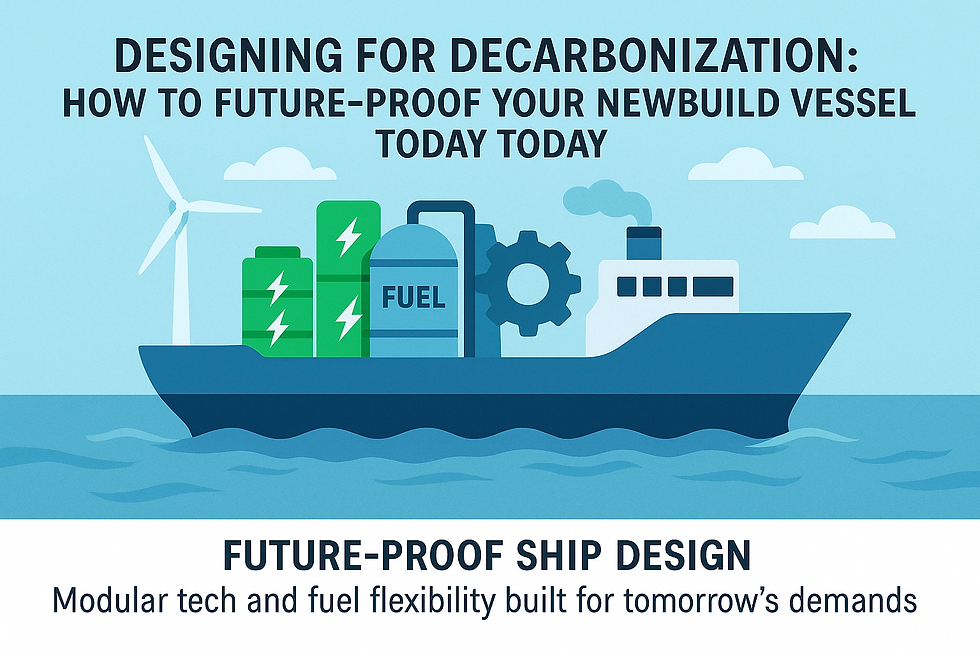Newbuild Risks for Shipyards: Challenges, Penalties, and How to Stay Afloat
- Davide Ramponi

- 11. Feb.
- 4 Min. Lesezeit
Aktualisiert: 30. Mai
My name is Davide Ramponi, I am 20 years old and currently training as a shipping agent in Hamburg. In my blog, I take you with me on my journey into the exciting world of shipping. I share my knowledge, my experiences, and my progress on the way to becoming an expert in the field of Sale and Purchase – the trade with ships.

While newbuild projects are often discussed from the shipowner’s perspective, the shipyards themselves also face considerable risks. Behind each gleaming new vessel lies a complex web of logistics, resource planning, and financial pressure—all of which must be managed with precision.
Shipyards take on enormous responsibility when accepting newbuild orders. Delays, rising material costs, contractual penalties, or workforce shortages can turn a profitable project into a financial headache. So how can shipyards mitigate these risks, and what happens when things go wrong? In this post, I’ll walk you through the typical challenges, provide insights into risk reduction strategies, and share real-world case studies of shipyards that faced critical difficulties.
Typical Risks for Shipyards During New Construction
Every newbuild project is a balancing act—between time, quality, cost, and compliance. If one part slips, the entire operation can be thrown off course. Let’s look at the most common threats:
1. Project Delays and Scheduling Conflicts
🔹 Causes:
Supply chain disruptions for key components.
Design changes made late in the process.
Inadequate project management or workforce shortages.
🔹 Consequences:
Missed delivery deadlines.
Penalty payments under the shipbuilding contract.
Loss of customer confidence and future orders.
2. Contractual Penalties and Legal Exposure
🔹 Most shipbuilding contracts include liquidated damages clauses.
If the ship isn’t delivered on time or fails performance standards, the shipyard may be liable for daily penalties or even order cancellations.
🔹 Penalties may also apply for:
Failing to meet fuel efficiency targets (EEXI/CII compliance).
Poor workmanship or technical failures discovered during sea trials.
3. Resource Constraints: Labor, Materials, and Financing
🔹 Many shipyards rely on just-in-time delivery of steel, engines, and equipment.
🔹 Shortages or price spikes can lead to cost overruns.
🔹 Workforce challenges—especially during pandemics or in low-wage regions—can slow progress.
🔹 Additionally, cash flow is tight in many projects, especially if milestone payments are delayed or financing is uncertain.
How Shipyards Can Minimise Risk
To survive and thrive, shipyards need proactive risk management and strategic planning. Here are key strategies:
1. Build Realistic and Flexible Project Timelines
✅ Avoid overpromising. Commit to realistic delivery schedules with buffer periods built in.
✅ Factor in possible delays from suppliers or external inspections.
2. Strengthen Contract Negotiation and Legal Safeguards
✅ Clarify force majeure clauses to protect against unforeseen global events.
✅ Negotiate grace periods or capped penalty limits in case of delays.
✅ Use modular construction methods to improve efficiency and reduce rework.
3. Diversify Supplier and Labor Networks
✅ Maintain multiple supplier relationships for critical components.
✅ Cross-train workers to avoid dependency on a few key specialists.
✅ Outsource non-critical parts of the project if local resources are unavailable.
4. Maintain Strong Financial Oversight
✅ Monitor cash flow closely—especially for multi-vessel projects.
✅ Secure refundable payment guarantees to reduce the impact of cancellations.
✅ Avoid underbidding contracts just to win business—it often leads to losses later.
Case Studies: When Shipyards Run into Trouble
Shipbuilding is a capital-intensive business, and even major players can run into difficulties. Here are two examples that highlight how risk can spiral into crisis.
Case 1: STX Offshore & Shipbuilding (South Korea)
Once one of the largest shipbuilders globally, STX filed for bankruptcy in 2013 after a series of cash flow problems and order cancellations.
🔹 What went wrong?
Overreliance on bulk carrier orders during a market downturn.
Aggressive expansion without securing sustainable financing.
Inability to deliver ships on time, leading to massive penalties.
🔹 Lesson: Growth without financial discipline is risky. A well-managed backlog is more important than a full one.
Case 2: Kleven Verft (Norway)
Kleven Verft, known for building advanced offshore vessels, entered restructuring in 2020*
🔹 What went wrong?
Shift in oil & gas markets reduced demand for high-end offshore ships.
The shipyard had committed to several complex vessels without sufficient margins.
Material and labor costs exceeded estimates.
🔹 Lesson: Even technologically advanced yards must hedge against market shifts and cost escalations.
Conclusion: Risk Awareness Is Critical for Shipyard Success
While shipowners focus on delivery and performance, shipyards shoulder significant commercial and operational risks during newbuild construction.
🔹 Delays, penalties, and resource shortages are common—but manageable with the right systems in place.
🔹 Transparent communication, strong contract negotiation, and realistic planning are key to staying profitable.
🔹 Past failures show that aggressive growth, weak oversight, or market overexposure can lead to collapse—even for major yards.
For shipyards, the goal isn’t just building great ships—it’s doing so on time, on budget, and with eyes wide open to the risks involved.
Have you seen shipyards struggle with newbuild projects? What strategies do you think work best to manage risks? Share your thoughts in the comments—I look forward to the discussion! ⚓🏗️





Kommentare